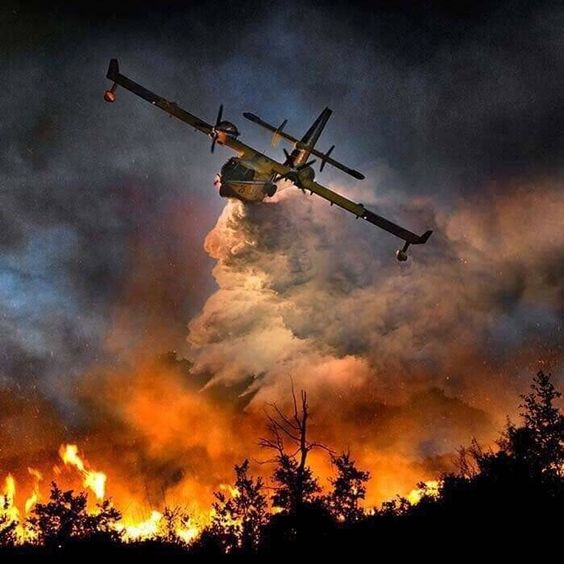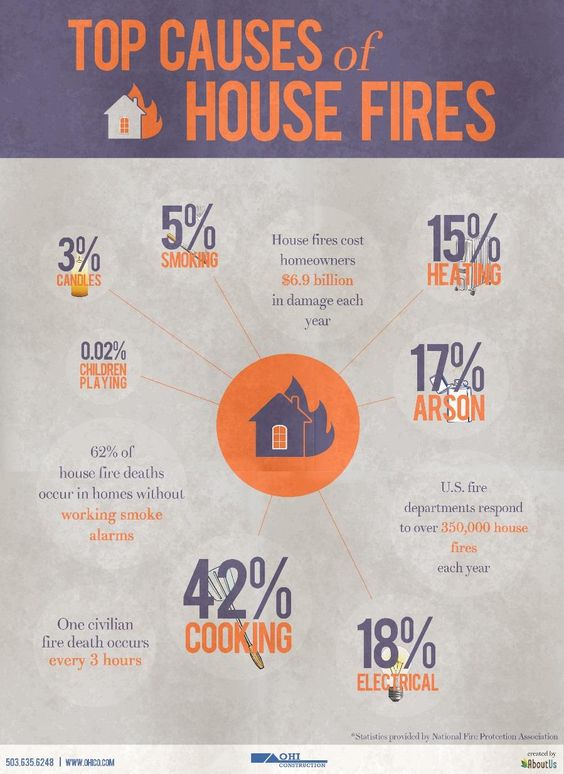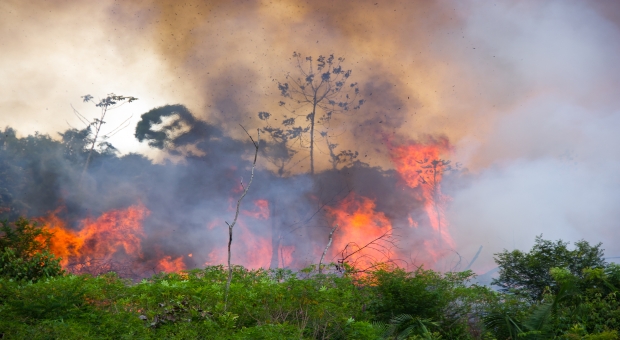Wildfires in California and Australia have sparked comments from those on the left about the planet burning up.
But this is nothing compared to what’s happening today. The massive fires in the Amazon jungle have become an international crisis. Huge fires in Siberia are adding to the blaze, as well as large swaths of the savanna in Central Africa burning off. If one were to look at just the fires going on today, it would be easy to think that the whole world is going up in flames.
Of these, the biggest concern is the burning of the Amazon jungle. The Amazon is known as the world’s “lung” where the vegetation that takes in the largest percentage of the world’s CO2 and produces the largest amount of oxygen is burning as well. If too much of that jungle burns off, it could drastically alter the composition of the world’s atmosphere, adding to the CO2 in the air.
Six million acres of timber have been charred in Siberia, an area roughly the size of New Hampshire. Alaska, one of the most pristine states in the USA, has had more than 2.5 million acres of tundra and snow forest burned off.
These numbers sound huge, and in reality are; but when you compare them to the total surface area of the world, they aren’t as huge as they sound. Even so, the big question is what difference the loss of so much plant life will make in the overall balance of life and world climate.
According to proponents of climate change, the big concern from these fires is the increase of CO2 levels, as CO2 is a “greenhouse gas.” What this means is that together with other greenhouse gases, carbon dioxide helps to trap in the effects of sunlight striking the earth, holding in the heat that the sun’s light generates.
Global Warming, or as it’s now called “Climate Change” is the concern that too much of an increase in the world’s overall temperature will have drastic effects on the climate, perhaps serious enough to destroy life. With this as the basis and little overall understanding of the world’s climate, it’s no wonder that fear mongers can use this to drive their agenda, moving the masses to fear.
Let’s Talk Climate Change
One of the big political questions that faces us today is whether climate change is real or not. Those who are proponents of climate change point to the rest of us, calling us “climate change deniers,” trying to make us sound like bad people because we don’t agree with their message of doom and gloom. But why is that so?
For one thing, little evidence is presented to support climate change, either the world getting hotter or the world getting colder. Rather, a lot of computer projections, predictions and poorly run studies have presented, showing how the world is being destroyed by supposed climate change. We’ve all heard how polar bear populations were dying off, and then later heard that they aren’t. We’ve also heard how some islands seem to be sinking into the ocean, about to be swallowed up by rising sea levels.
A supposed consensus of “97% of climate scientists” is used regularly as the authority to state that climate change is real. But that figure has been debunked as a manufactured number, based on a very flawed study, which was created to generate the kind of results it did.
But is the climate actually changing?
The truth is that the climate is always changing; historic records prove that. There have been times in the history of the world which have been colder than it is now, as well as times when it has been hotter. Somehow, life has managed to continue on, regardless of how the climate changes. Perhaps some life forms have had to adapt or to move to a different area where they can thrive as the climate has changed, but they survived.
What’s really being debated isn’t whether the climate changes, but rather whether the climate change that we are having now is a dangerous warming trend that can cause catastrophic problems and whether that change is caused by man, specifically by man’s burning of fossil fuels.
Actually, the debate that is happening in the public and political sphere has little to do with science. Rather, it’s all about agenda. Proponents of the climate change agenda have long held that the world is going to be destroyed, if we don’t stop burning fossil fuels. Their solution to this problem is to punish countries that produce too much carbon (supposedly by burning fossil fuels) by charging them huge amounts of money. Apparently that is supposed to make a difference.
I remember this debate when I was in high school. The question was whether the world would die in fire or in ice. In either case, it was man-made pollution that was going to destroy the world and it was up to us to do something about it. The question was… what?
Carbon Dioxide’s Place in the World
 Carbon dioxide is regularly pointed to as the major greenhouse gas causing global warming. Yet few people know what this essential chemical is or what it does. All they know is that it is considered a greenhouse gas, along with methane, ozone and water vapor.
Carbon dioxide is regularly pointed to as the major greenhouse gas causing global warming. Yet few people know what this essential chemical is or what it does. All they know is that it is considered a greenhouse gas, along with methane, ozone and water vapor.
But carbon dioxide does more than that. Humans and animals breathe in air to get oxygen, an essential element for our bodies to use. In the process of using it, the oxygen is bound together with carbon, creating carbon dioxide. So we too are producing greenhouse gases, every time we take a breath.
It would seem that with so many people and animals populating the earth for such a long time, that all the CO2 we produce would be disastrous on its own, without burning fossil fuels, if the climate change group is right. Yet the CO2 levels in the atmosphere today are 405.0 PPM (parts per million). Proponents of climate change say that this is the highest level of CO2 in the atmosphere in about 880,000 years.
So why isn’t it higher? How can it be that it was higher at any point in the past, if it is causing the climate to get warmer?
The truth is that plants breathe in carbon dioxide and breathe out oxygen, a wonderful part of the balance of life here on planet Earth. As long as the balance between plant life and animal life stays within certain parameters, the overall level of carbon dioxide in the air shouldn’t reach a point where it can no longer sustain life.
In reality, plants would grow better with more CO2 in the air. Figures I’ve seen say that the ideal level of CO2 in the atmosphere, to provide the best possible growth for plants, is about three times as much as what we have today. Scientists have discovered that there have been periods in the past when the CO2 levels were higher than they are today.
Interestingly enough, when you graph out the world’s average temperature through history and the level of carbon dioxide, there isn’t any correlation between the two. Yet climate change proponents swear that CO2, the same CO2 that plants need to have in order to survive, is the prime culprit.
Actually, it isn’t just any CO2 that supposed to be causing the problem, but the CO2 produced by burning fossil fuels. Somehow, those who talk about climate change never seem to talk about the huge amount of carbon dioxide that comes out of the oceans every day; nor the water vapor (another greenhouse gas) which evaporates from the oceans either.
Is the Burning Planet a Real Risk?
The burning of vast acres of forests and jungles that we’re seeing today is startling. It makes for great news stories. But is it an existential risk to man? I doubt it. Things would have to get much worse than they are today, before they would make a significant impact on life.
That’s not to say that we should ignore it altogether. Ignored long enough, the burning that is happening could reach a critical point. Therefore, it is something we should be aware of and concerned about. Besides, the burning of all that lumber, which could be used for other purposes, is wasteful, creates pollution and can destroy property, as we saw last year in California, when the Camp Fire burnt down the town of Paradise.
Yet a certain amount of that burning is a natural part of the renewal of forest growth, a normal part of the globe’s life, even without mankind being here to start fires. While man has started many a forest fire, Andrew Cunningham Scott has done an amazing study of the history of fire, showing how it is a normal part of the life cycle of the forest. His book, “Burning Planet” is rather academic in nature, but clearly demonstrates how the burning off of vast acreage of the world’s forests is a normal part of the cycle of life.
On a more personal level, I remember growing up in Colorado, where the swaths of pine and aspen trees in the mountains show the story of past forest fires. Looking at those, one could see how the various fires had burned off areas, allowing the new growth forest to begin. This kept the forests young and able to provide food to the animals living there.
Yes, there are real risks from extensive burning; but there are also potential benefits. The greatest of these benefits is in rapid growth of plant life. An increase in CO2 levels will always spark a growth in forests and other green areas. Plants will thrive, leading to an increase in herbivores and then the carnivores who hunt them. Nature will find its balance, without mankind’s interference.

Preparing for a Burning World
While I haven’t seen enough evidence to convince me that climate change is really an issue we need to be concerned with, I don’t feel that it should be ignored either. The truth is, we don’t know enough to make a realistic evaluation, as those who are holding the actual data are guarding it closely, only allowing others to see their conclusions. While that isn’t very professional, it’s the reality of “science” in the modern world.
As I mentioned earlier, I’ve heard of the world ending either in fire or ice all my life. So the question is, what is a realistic scenario and how will we survive it?
The bigger risk with extensive forest fires isn’t from the carbon monoxide, but from ash. It is extremely doubtful that enough of the world’s forests and jungles can burn to reduce the available oxygen levels in the air to a point where it won’t sustain animal life.
Oxygen is 21% of our atmosphere at sea level. That’s 525 times more than the CO2 level. In comparison, the oxygen level at 12,000 feet is only 13.2%. While the body’s ability to function is severely limited at that altitude, it is still possible to survive. So, it would take a lot of burning to lower the oxygen level to the point where we couldn’t survive.
On the other hand, 1816 is known as “the year without a summer” because of the severely cold weather caused by the eruption of Mount Tambora in what is now Indonesia. It wasn’t the change in oxygen or carbon monoxide levels that made a difference, but rather the amount of soot in the air. That soot was blocking the sunlight, keeping the sun’s light from warming the surface of the earth. Many crops failed that year, due to the colder climate.
So basically what we need to concern ourselves with is the ability to grow food in either hotter or colder temperatures than what we’re accustomed to. But in reality, people already grow food in climates which are both warmer and colder than what we are accustomed to growing in. If they can accommodate those temperatures, than we should be able to as well.
We may end up having to grow different vegetables than we’re accustomed to, but we can still grow vegetables. That’s even true in hot climates. The trick then is keeping the plants cool enough that they don’t die, just as the trick in a cold climate is to keep the plants warm enough that they don’t freeze. Methods exist for both.
The other issue that’s raised all up all the time is the rising of the oceans. While that is often associated with global warming, I’d say that chances are greater that it has been caused by the shifting of the poles. While the North Pole has been losing icepack, the South Pole has been gaining it. So the overall icepack on the combined poles is probably about the same, even though the icepack in the far north is diminishing. Of course, that’s all the global warming crowd talks about, ignoring what’s happening at the South Pole.
So, how do we deal with that? Simply by making sure that we’re ready for the rising of the oceans. Anyone living along the coast should be doing that anyway; not only for rising oceans, but for dealing with storm surge. If seawalls and dikes can’t solve the rise they are encountering, then maybe it’s time to move to higher ground.



















































































This is an excellent article, one that will surely enrage the Democrats, and especially Al Gore, who profits mightily by trading carbon credits. It will most likely send AOC into spasms, since her Green New Deal DEPENDS on support from climate change extremists. It is no doubt appreciated by The Heartland Institute, which has been saying the same thing for decades. The only thing this article missed was pointing out that warming periods CAUSE increased levels of carbon dioxide, not the other way around.
The Human expulsion of CO2 (Due to the Enormous Human Population Growth) is far greater than All fires. Only the Oceans can compete.
Like the article said the climate is always changing. I know a man who told me that in the 30’s or 40’s not sure which decade it was that he can remember a summer that they did not have summer. Winter started one year followed by a year of winter (spring, summer, fall and again winter until they finally had spring the following spring. This was in Illinois and he said that the year spring came his father had to go to Georgia to buy seed. . All I can say is the doom and gloomers don’t read the BIBLE at all or they would realize the weather is in GOD’S hand.
John 9/4/2019
If the world is burning up people should realize that God said he would destroy the earth with fire , so it’s a great time to ask God to forgive you of your sins so you can go to heaven before it’s too late .